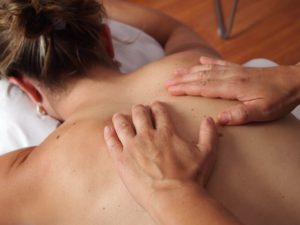In my upper back, on the left side, half-way between my neck and shoulder, I have a muscle knot that feels like a small potato. It’s hard, thick, and unmistakable. And it causes me pain. When it acts up, it gets tight and achy and can be Ground Zero for migraines that can take me down for a day or two. I know—a migraine that starts in my shoulder? WTF?
So what exactly is a muscle knot and why can they be so miserable?
 At the most basic level, your muscles are made of fibers. They are also layered on top of each other, and most muscles run in different directions from those above or below. To do the work of moving your skeletal structure, your muscles need to be flexible and stay pliant. However, when you continuously use the same position, injure a muscle, or even become chronically dehydrated, your normally elastic muscle layers and fibers start to adhere to each other. This adhesion can feel hard, lumpy, and uneven—a muscle knot.
At the most basic level, your muscles are made of fibers. They are also layered on top of each other, and most muscles run in different directions from those above or below. To do the work of moving your skeletal structure, your muscles need to be flexible and stay pliant. However, when you continuously use the same position, injure a muscle, or even become chronically dehydrated, your normally elastic muscle layers and fibers start to adhere to each other. This adhesion can feel hard, lumpy, and uneven—a muscle knot.
Lots of people have knots in their muscles. Some are harmless and others can be attention-getters, like the one in my upper back. Over time, knots can become scar tissue, and cause a loss of muscle elasticity and function. They can also be a source of a great deal of pain.
In Chinese medicine, muscle knots are considered to be a blockage or area of stagnation, which means that something isn’t moving as it should. In the case of a knot, what’s not moving is the muscle, but also the circulation of blood and nutrients in the area. Beyond just feeling like a lump, muscle knots tend to have a personality in Chinese medicine. Some feel better when you apply ice, and others respond better to heat. Some are painful to the touch, but others feel immensely better being worked with a lot of pressure.
The good news is that Chinese medicine has a number of tools to deal with muscle knots. One of the most important of those tools is acupuncture. A particularly effective technique to resolve knots involves gently twisting a needle that has been inserted into the knot to affect the adhered muscle fibers. A series of these treatments can noticeably shrink a knot and relieve pain.
Another technique available through Chinese medicine is called Gua Sha and involves scraping the skin in the area above the knot. This causes a light bruise-like abrasion which can help soften the knot, stimulate circulation, and promote healing. While Gua Sha sounds scary and painful, in reality it’s not; some patients would tell you that it feels good, especially on a particularly difficult knot. Another method called Tua Na, which is an Eastern form of body work, can be helpful in moving the muscle fibers and increasing circulation. Tui Na involves various massage-like techniques that manipulate acupuncture points and pathways.
Beyond acupuncture and Chinese medicine, there are some other things you can do if you have stubborn and painful muscle knots. Among them:
-Get a massage. A series of massages can help relieve pain, increase circulation in the area, and help release adhesions that are causing your knot.
-Physical therapy can also be helpful. A physical therapist can help identify what’s causing your knot, perform massage, help stretch the muscles involved, and provide you with exercises and stretches to do at home.
-Stretch the area involved. Treat your knotty muscle gently, but if possible, slowly stretch the muscle involved through its full range of motion. If your range of motion is severely restricted, try warming the muscle for five or ten minutes first.
-An ounce of prevention when it comes to muscle knots includes staying well-hydrated, taking breaks from your desk or computer, exercise, good posture, and regular massages to keep the muscles supple and flexible.
As for the knot in my upper back, it persists because I get too busy or complacent to take care of it the way I should. Only when it’s really acting up do I do anything about it. Then, when I get a little acupuncture, a couple of massages, and quit hunching over my computer, it calms down considerably.



